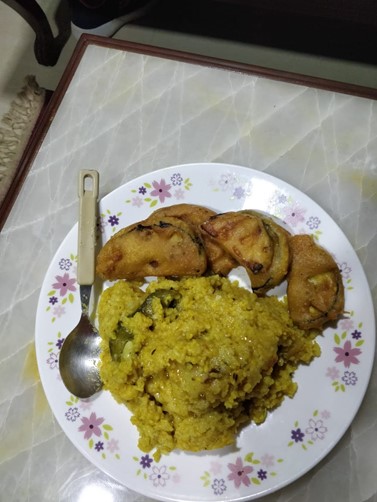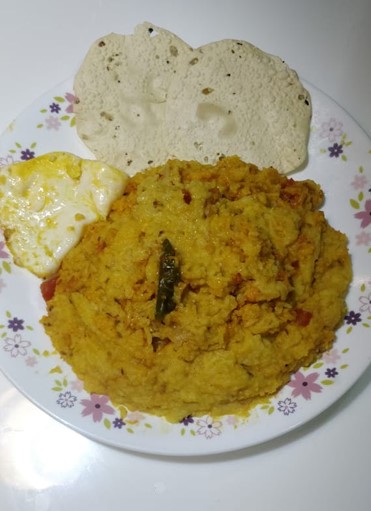An Ode to Khichuri, the comfort Indian Porridge
Growing up as a picky eater who could pick the vegetables out of their fried rice in under 2 minutes, I really had a limited food palate. I was not a huge fan of meat based dishes, fish dishes scared me and my reaction to vegetarian dishes was: EW! But there was one thing that I really liked and that was, being around food and listening to my family talk about food and food history.
 I grew up in a food-obsessed Bengali family (let’s be honest, most Bengalis are food-obsessed). My family came to West Bengal from different parts of Bangladesh during the Partition. So our cooking and eating style is predominantly Bangal, a colloquial term for the erstwhile residents of Bangladesh (Ghoti is a colloquial term for the residents of West Bengal). However, staying in West Bengal for so many years/generations now, we have become fans of certain Ghoti dishes (I like prawns more than hilsa, there I said it!).
There is one dish, however, that connects the Bangals and Ghotis alike. It also connects the Probashis (Bengalis that reside in other parts of India, like my family) and gives us a sense of collective heritage. That dish is: Khichuri. Khichuri or Khichdi or Khichda, whatever you call it, is an Indian rice-lentil porridge dish. It is our comfort dish as well as the dish we eat when we are feeling under the weather. It is also a celebratory dish during our religious ceremonies. Conceptually, it is similar to a Congee with the addition of spices. Every family has their own iteration of Khichuri. In Bengal, we have three kinds (I think).
I grew up in a food-obsessed Bengali family (let’s be honest, most Bengalis are food-obsessed). My family came to West Bengal from different parts of Bangladesh during the Partition. So our cooking and eating style is predominantly Bangal, a colloquial term for the erstwhile residents of Bangladesh (Ghoti is a colloquial term for the residents of West Bengal). However, staying in West Bengal for so many years/generations now, we have become fans of certain Ghoti dishes (I like prawns more than hilsa, there I said it!).
There is one dish, however, that connects the Bangals and Ghotis alike. It also connects the Probashis (Bengalis that reside in other parts of India, like my family) and gives us a sense of collective heritage. That dish is: Khichuri. Khichuri or Khichdi or Khichda, whatever you call it, is an Indian rice-lentil porridge dish. It is our comfort dish as well as the dish we eat when we are feeling under the weather. It is also a celebratory dish during our religious ceremonies. Conceptually, it is similar to a Congee with the addition of spices. Every family has their own iteration of Khichuri. In Bengal, we have three kinds (I think).
The first kind is a Bhoger Khichuri or Khichuri given to the Gods as an offering. It is made of rice, yellow lentils, some vegetables, mildly spiced with turmeric and ginger paste. In Bengal, we call this Niramish style: vegetarian dishes cooked without onions or garlic. The Bhoger Khichuri is usually a little on the liquid-y side and is served with different kinds of batter-fried vegetables like eggplants, potatoes, pumpkins and giant dollop of ghee. The other kind is a regular Homestyle Khichuri, made with red lentils and rice. It doesn’t follow the no onion-no garlic rule. I guess, this style would be more synonymous to the broader Dal Khichdi which you get in other parts of the country. A general accompaniment to this homestyle khichuri is an egg omlette (with specks of chili and onion). There is also a third kind that I am aware of: Bhuna Khichuri. It is a more drier style of khichuri that kind of resembles a pulao/pilaf texture. I can concur that all three kinds are equally tasty and heart-warming. Khichuri also has an international cousin: the Kedgeree, a breakfast dish in the UK. This dish is part of the Anglo-Indian cuisine with the addition of fish and removal of lentils once it reached the UK shores.
Now you might be wondering why I am rambling about Khichuri and why I am writing an ode to it. That is a fair question to ask. Well, I have a special sentimental relation to Khichuri. You see, as a picky eater, the only dish that I would actually eat while growing up was Khichuri. And to be more specific: the Khichuri made by my maternal grandmother, aka Didun. Didun was an expert in the Bhoger Khichuri genre and her vegetable of choice for Khichuri was always big hunks of potato and cauliflower, the two vegetables that I actually like to eat. Now as all Indian grandmothers, she didn’t really write down her recipes. She made it with the “feels right” attitude that is staple to Indian cooking.
 Unfortunately, my Didun passed away in 2014 during my birthday month. I miss her dearly and I definitely miss her cooking and all the food stories that she would share with me while she worked her magic in the kitchen. To remember her and the special place that she has in my heart, I always eat a big bowl of khichuri on my birthday. At this point, it has become my birthday tradition. It just reminds me that my Didun will always be there for me and blessing me with her big bowl of Khichuri as I start a new revolution around the Sun. It is a bit strange to eat a dish that is literally given to patients in the hospital. Usually, a typical Indian celebratory dish would be Biriyani. But this is a Khichuri appreciation post and I am never the one to follow the conventional trend. Therefore, Khichuri on my birthday is a MUST.
Now, as I said, my Didun didn’t really leave behind any recipes for us to follow and recreate. But thanks to several hours spent on Youtube and remembering the flavor of the dish from memory, I think I can finally muster up a dish that comes close to what her’s was like. It will never reach the heights of her Khichuri but it will live on in my family line as the dish that gives you a hug when you eat it. I found some videos on Youtube that produced best results for Khichuri, in my opinion. I am posting the links to those videos here and I do hope you get to try some Khichuri whether you are joyously celebrating your life or it is one of those days when you just need your food to give you a tight hug.
Unfortunately, my Didun passed away in 2014 during my birthday month. I miss her dearly and I definitely miss her cooking and all the food stories that she would share with me while she worked her magic in the kitchen. To remember her and the special place that she has in my heart, I always eat a big bowl of khichuri on my birthday. At this point, it has become my birthday tradition. It just reminds me that my Didun will always be there for me and blessing me with her big bowl of Khichuri as I start a new revolution around the Sun. It is a bit strange to eat a dish that is literally given to patients in the hospital. Usually, a typical Indian celebratory dish would be Biriyani. But this is a Khichuri appreciation post and I am never the one to follow the conventional trend. Therefore, Khichuri on my birthday is a MUST.
Now, as I said, my Didun didn’t really leave behind any recipes for us to follow and recreate. But thanks to several hours spent on Youtube and remembering the flavor of the dish from memory, I think I can finally muster up a dish that comes close to what her’s was like. It will never reach the heights of her Khichuri but it will live on in my family line as the dish that gives you a hug when you eat it. I found some videos on Youtube that produced best results for Khichuri, in my opinion. I am posting the links to those videos here and I do hope you get to try some Khichuri whether you are joyously celebrating your life or it is one of those days when you just need your food to give you a tight hug.
Links:
- Banglar Rannaghor
- Spice Bangla Bhuna Khichuri recipe
- Bong Eats Khichuri Recipe
- Nigella Lawson’s Salmon Kedgeree
Category: food